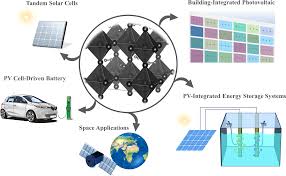Perovskite Solar Cells: New Study

Swedish scientists at Chalmers University of Technology have used AI-enhanced simulations to solve the long-standing puzzle of halide perovskite instability.
- A Perovskite Solar Cell (PSC) is a type of thin-film photovoltaic device that uses perovskite-structured compounds (ABX₃) as the light-absorbing active layer.
- Perovskite Material Named after the mineral Calcium Titanium Oxide (CaTiO₃).
- General chemical formula: ABX₃, where ‘A’ and ‘B’ are cations and ‘X’ is an anion.
- In solar tech, it usually refers to metal halide perovskites: hybrid organic–inorganic compounds with a metal cation (Pb²⁺, Sn²⁺), halide anion (I⁻, Br⁻, Cl⁻), and organic cation (methylammonium, formamidinium).
- Advantages:
- High power conversion efficiency (PCE) (over 25% in labs).
- Thin, lightweight, and flexible → can be applied on windows, buildings, smartphones, and vehicles.
- Low-cost fabrication compared to energy-intensive silicon processing.
- Potential use in tandem solar cells with silicon for even higher efficiency.
- Efficiency Potential: It is known for high light absorption, excellent charge transport, and bandgap tunability and also achieved power conversion efficiencies (PCEs) above 25%, comparable to silicon cells.




